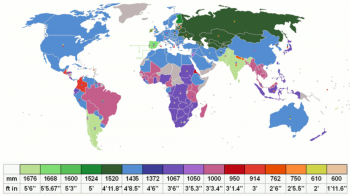We are developing the social individualist meta-context for the future. From the very serious to the extremely frivolous... lets see what is on the mind of the Samizdata people.
Samizdata, derived from Samizdat /n. - a system of clandestine publication of banned literature in the USSR [Russ.,= self-publishing house]
|
There’s a fruit store on our street
It’s run by a Greek.
And he keeps good things to eat
But you should hear him speak!
When you ask him anything, he never answers “no”.
He just “yes”es you to death, and as he takes your dough
He tells you
“Yes, we have no bananas
We have-a no bananas today.”
Those are some of the words to the 1923 hit song “Yes, We Have No Bananas” by Frank Silver and Irving Cohn. The song is mostly associated with World War II, but according to Wikipedia it had found its way into the history books before that:
The song was the theme of the outdoor relief protests in Belfast in 1932. These were a unique example of Protestants and Catholics in Northern Ireland protesting together, and the song was used because it was one of the few non-sectarian songs that both communities knew. The song lent its title to a book about the depression in Belfast.
For nine decades “the depression” meant the one that started in 1929. But the coronavirus looks likely to bring in its wake an economic depression that may well take the definite article for itself. Naomi O’Leary of the Irish Times reports,
Euro finance ministers reach compromise to fund pandemic recovery
Deal dashes hopes of Italy, Ireland and seven others for the roll out of so-called corona bonds
The 19 members of the euro zone agreed a compromise on Thursday to aid states in need of funding to address the profound economic fallout from the coronavirus pandemic.
But it dashed the hopes of Italy, Ireland, Spain and six other member states that had called for eurobonds to bring down borrowing costs and send a signal of unity as the continent confronts a health crisis that is threatens to become an economic disaster.
Under the deal, states can borrow from the European Stability Mechanism bailout fund to finance spending needed to overcome the crisis.
I do not seek to play down their achievement in reaching a compromise at all. Every finance minister on Earth must be passing sleepless nights wondering how best to deal with our current predicament. But the dilemma faced by the Eurozone countries is particularly acute. Italy and Spain will never forgive the EU if they receive no help in their hour of need. But the northern countries were repeatedly assured that EU membership and the adoption of the Euro would never mean they had to write a blank cheque to what they see as the spendthrifts to the south (and a few other directions besides). The Dutch, the Germans, the Finns and the Austrians must hope that when they say, “yes, we have no Eurobonds” the upbeat momentum of the first three words will carry them over the next two.
The ‘conservative’ Spanish newspaper/site abc.es. has a report about the food situation in Italy (in Spanish) which indicates the following, something our media seems to ignore, per my translation:
‘Increasing woe in Italy due to the coronavirus: almost 3,000,000 people need food aid’
There’s a 10% uplift there, as the report gives a breakdown with more details.
In Campania more than 530,000 people need food, almost 9% of the region’s population. More than 364,000 in Sicily, almost 283,000 in Calabria. Even Lazio has more than 263,000 people in need. One analysis says around 2,700,000 people need food aid.
There is much discussion of raids on pharmacies and supermarkets, with police guarding them. This might be Southern politicians screaming for ‘pork’. Or perhaps the economy collapses when the State imposes lockdowns.
The Italian State has responded (to the problem it created)
Urgent response of the government
On Saturday night, the government responded urgently to this cry of alarm from the whole South of Italy, where there is a grave risk which some have called a ‘Social Bomb’ or ‘A Social Powderkeg’ which could explode if urgent solutions aren’t found.
The Prime Minister announced on Saturday night aid of 4,300,000,000 euros for families (Mr Ed. What type of family?) and another 400,000,000 euros in vouchers “to help the citizenry who have no money to buy basic necessities”
Or is this about something else? This paragraph caught my eye:
The challenge of the black economy
The ex-president of the National Anticorruption Authority, Raffaele Cantone, a prestigious Napolitan magistrate, has indicated that the true challenge is the black economy, with thousands of people who are now helpless: «It’s about the existence –says Cantone– of a parallel economy which everyone knows about, which some, and not only Southerners, exploit and many others tolerate, hypocritically pretending that they can’t see it.»
And how long here before our food supply chains might disintegrate, when people have to laboriously shop 2 meters apart, queueing to get in, queueing to pay, as the capacity of the shops to serve customers is throttled, whether or not the products are limited or in short supply. Is there any modelling of how long this can go on, never mind if it should at all?
Just now, a lot of people have a lot of time on their hands, and might therefore be open to the idea of watching and listening to a talking head for the best part of an hour. Accordingly, I now recommend this video interview, which I myself have just watched for the first time. Steve Edginton of the Sun newspaper asks a few short questions. Melanie Phillips supplies some much longer answers.
At the end of the interview, Phillips mentions a couple of relevant books she has written. These are her novel, The Legacy, and her memoir about how she used to work for the Guardian, Guardian Angel: My Journey from Leftism to Sanity.
A lot of us also now have more time for books. For actually reading them, I mean.
Melanie Phillips did this interview a few days ago. I wrote this Samizdata posting about Labour antisemitism in May 2018. I deduced what I did from the distant din of battles which I was not personally part of. Phillips tells the same story from direct personal experience, along with several other closely related stories.
Like I say: highly recommended.
Beneath and beyond all the fretting we’re all now doing about The Virus, the onward march of technology continues.
I get emails from Google about advances in 3D printing, and each email contains lots of links, far more links than in any other Google emails I get on other subjects.
Links like this one, to a report about some newly contrived magnets:

Note the bit at the bottom on the right, where you learn the size of these things. They are very small.
Why are miniature magnets like this so important? And why do they have to be 3D printed? That’s what ignorami like me want to know. The anonymous writer of the report accordingly begins it thus:
Magnetic materials are an important component of mechatronic devices such as wind power stations, electric motors, sensors and magnetic switch systems. Magnets are usually produced using rare earths and conventional manufacturing methods. …
A bit later he says:
Permanent magnets are incorporated into a number of mechatronic applications. Traditional manufacturing methods such as sintering or injection moulding are not always able to cope with increasing miniaturisation and the resulting geometric requirements for magnets, and this is a trend which is sent to continue in the future. Additive manufacturing processes offer the necessary freedom of design. …
I had to look up sintering. Blog and learn.
→ Continue reading: Thoughts provoked by some 3D printed miniature magnets
The 1619 project wasn’t about being right. It wasn’t even about history. It was about pushing an anti-American narrative. It’s best understood as a psywar operation aimed at demoralizing the enemy, in this case the American people.
– Glenn Reynolds
One of my favourite places to find SQotDs is in the little summaries of issues that Glenn Reynolds often adds to the links he supplies.
Just to give a light tap to a small drum, which nobody else will tap if neither of us does, and just to say: fellow Samizdatista Patrick Crozier and I recently did one of our recorded-and-internetted conversations, this time about that strange event called in these parts: The Falklands War, which happened in early 1982. Listen to this by going here. Further thoughts about this historical event and this conversation from me here. (See also an earlier posting I did, about a very strange British public personality who emerged onto British TV during that war.)
Somewhat inconveniently, for many, our conversation does rather go on a bit, for over an hour. But I have recently been finding myself spending what used to be my television time instead listening to things not unlike these conversations that Patrick and I have taken to doing – podcasts, YouTubery and so forth (many of these things involving Dave Rubin (a recent discovery of mine)). So I thought it worth mentioning our effort(s) here.
Some MapPorn:

This is a map of the world’s different railway gauges.
Fun fact, if fact it be. In the schmoozing after a talk I attended earlier in the week, someone told me that Britain’s four foot eight-and-a-half inch gauge is the result of how far apart horse-drawn carriages had their wheels, in the pre-railways north-east of England, that being where the railways in Britain got started. The point being that such carriages also had a standard gauge. Their wheels dug ruts in the un-tarred roads of those times, so if your carriage had a different “gauge”, it couldn’t travel in those ruts, and thus couldn’t travel at all. These ruts were rails before rails. And that regular distance apart transferred itself to the newly emerging railways.
I haven’t checked this. I didn’t want to bother with any facts that might destroy my story, until I’d told my story. But as of now: feel free to destroy away.
Another question: Will the railway gauges of the world ever change? By which I mean get somewhat less numerous. Say: As a result of some sort of new intercontinental high speed rail system being developed. I seem to recall reading that in Spain, the new high speed trains are the same gauge as those in France (and thus also Britain) and different from the regular Spanish gauge. Or would a some futuristic global high speed system will just add yet another standard? (Will Brunel’s preferred seven foot gauge for the old Great Western line rise from the dead and conquer the world? Guess: No.)
Cue the commentariat who will, I predict, change the subject to the QWERTY keyboard, and then disagree about how that happened, and about how keyboards will be in two hundred years time.
Of this:
Born in New York City in 1945, Tesler eventually studied computer science at Stanford University before working in the school’s artificial intelligence research lab in the late 1960s. He moved to Xerox in 1973, where he devised the time-saving concepts to cut, copy and paste in computer systems.
“Your workday is easier thanks to his revolutionary ideas,” Xerox tweeted Thursday to honor Tesler.
Oh, it goes far beyond that, for me and surely for many others. My whole life was made possible by this sort of stuff.
With thanks to Instapundit. It’s little postings like this that keep me going back there. If all there was there was politics, I’d keep going back, but surely not so often.
Imagine having to copy out just the two links above, letter by letter, number by number. Absurd.
A BIT LATER: I put together all of the above for my personal blog, but then I thought: this should go to Samizdata. So I copied and pasted it across. Took me about two minutes.
Frank Falla was a Guernsey journalist when the German occupation began in 1940. He became involved in the production of an underground newspaper and when he was eventually caught he was sent to a German prison (not – please note – a concentration camp). By the time the Americans liberated him he was little more than a bag of bones and close to death. The Americans put him up in a hotel so that he could recover. There he was served breakfast in bed by a German civilian. He writes:
I think her name was Trudi – and she was to spell trouble for some of the American boys. She was a young, attractive brunette who a week later had a pretty rough handling from some soldiers who found out where her bedroom was. Three of them took turns to sleep the night with her. Some of these boys were completely sex-starved after long training in England and fighting their way through France and Germany, and they took it out on this poor girl, who was a week recovering from the ordeal. Still, c’est la guerre!
And all this in an area that was later handed over to the Soviets.
In the spirit of what Julie near Chicago said in a comment, at 11:33am, on this, which was this, …
I love Samizdata. You learn so much arcane stuff hereabouts!
(She then adds, by way of example, something about the Cloak of Invisibility, whatever that is. (I’m not asking.))
… I will add another little bit of arcane stuff here. Before today ends, because it concerns today. I refer to this:
02 02 2020
This is the first time in over 900 years (since 11/11/1111) the date is palindromic no matter the date format.
I learned this in a tweet, which I encountered because the noted military historian Peter Caddick-Adams, with whom I was once upon a time acquainted and whose twitterings I now follow (and more to the point whose books I also read with great pleasure), drew it to my attention.
Although, what if you just say 2/2/2020? Doesn’t that count as a “date format”? I think I just destroyed this posting.
Personally, I always try to put the name of the month and only use a number for the day, because once you get confused about the all-numbers way of identifying dates the confusion only ends with your death. (When trying to work out when a photo taken early in the month got taken, I tend to get brain-ache and have to work it out like a crossword clue.)
I notice that Samizdata also uses month names for all dates. Very wise, and further proof of why all should love Samizdata.
Because if we don’t, who will? I consider myself quite well versed in history, and I am certainly disposed to honour those killed while fighting Communism, yet even I had barely heard of the Soviet-Polish war of 1920. I had not thought of it for years until reminded by a post by Glenn Reynolds of Instapundit:
The war that saved Europe from Communism
|
Who Are We? The Samizdata people are a bunch of sinister and heavily armed globalist illuminati who seek to infect the entire world with the values of personal liberty and several property. Amongst our many crimes is a sense of humour and the intermittent use of British spelling.
We are also a varied group made up of social individualists, classical liberals, whigs, libertarians, extropians, futurists, ‘Porcupines’, Karl Popper fetishists, recovering neo-conservatives, crazed Ayn Rand worshipers, over-caffeinated Virginia Postrel devotees, witty Frédéric Bastiat wannabes, cypherpunks, minarchists, kritarchists and wild-eyed anarcho-capitalists from Britain, North America, Australia and Europe.
|





